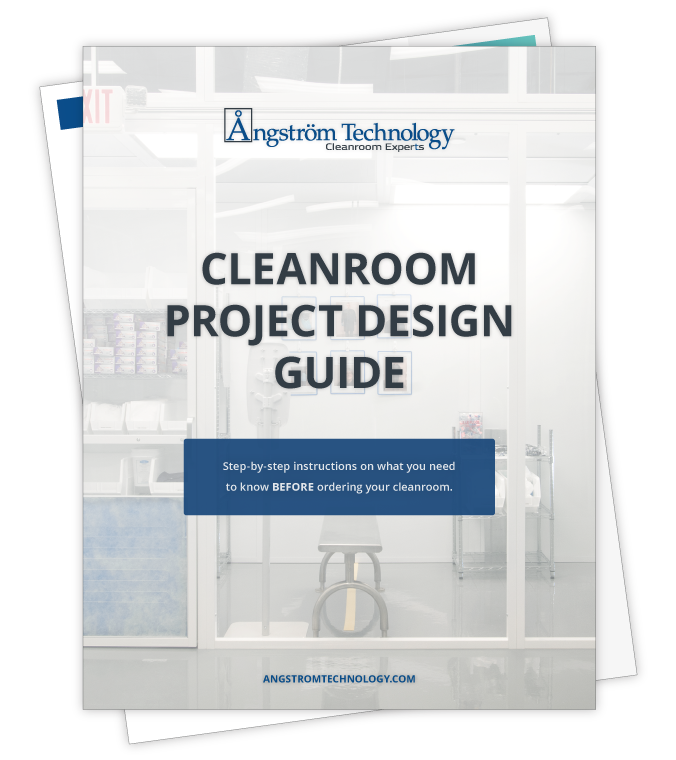For many facilities, floors are the most forgotten component of cleanroom design. However, the type of flooring you choose for a pharmaceutical cleanroom has a huge impact on overall contamination control and performance. This is of utmost importance when you’re working with consumables like medicines and supplements that need to be safe, effective, and repeatable.
4 Common Types of Cleanroom Flooring
Let’s take a look at four of your cleanroom flooring options. Then, we’ll give some insight on which may be best suited for pharmaceutical applications.
1. Heat-Welded Vinyl Cleanroom Flooring
Heat-welded vinyl is a seamless pharmaceutical flooring solution. It has no crevices for contaminants to accumulate in and expose your cleanroom to. It also provides the option to implement a cove base up the wall (typically 3 – 6”), which eliminates 90° corners where floors and walls meet and further prevents contamination to settle and be difficult to clean.
Heat-welded vinyl flooring is also easy to clean and can withstand harsh cleaning agents, lessening the burden of rigorous pharmaceutical cleanroom cleaning protocols. It’s relatively economical as well.
One downside of heat-welded vinyl flooring is that it can wear out quickly when exposed to heavy weights. But if you’re working in a pharmaceutical cleanroom with minimal heavyweight equipment, it’s a great overall choice.
2. Epoxy-Coated Cleanroom Flooring
Epoxy is a coating placed over a solid concrete substrate, usually in a three-part process. First, the flooring must be prepped with a combination of grinding, scarifying, shot blast, and filling in larger holes or cracks where moisture can seep in. A rough surface is necessary for the epoxy to adhere to. This coating allows for a seamless surface with no crevices for contaminants to build up and harm the integrity of your cleanroom. Similar to heat-welded vinyl, there’s also an opportunity to install a cover base that eliminates 90° corners where floors and walls meet.
Epoxy-coated cleanroom floors are dense with low porosity, which makes them easy to clean and durable, even when exposed to heavy weight and high traffic. They don’t shed any particles, and you can even opt to add anti-static features.
Epoxy-coated floors also come in a variety of colors, so you can choose which best suits your pharmaceutical cleanroom.
3. Polyurethane-Coated Cleanroom Flooring
Polyurethane is another coating placed over a solid concrete substrate, usually in a one- or two-part process. It exhibits a glossy or satin finish that maintains its shine even when exposed to heavy weight and high traffic. This light-reflecting property is great for extra illumination within the cleanroom environment.
Polyurethane-coated floors are also resistant to harsh chemicals and substances, which make them highly effective in industrial manufacturing cleanroom applications.
4. Interlocking Vinyl Tile Cleanroom Flooring
Interlocking vinyl tiles are newer to the cleanroom flooring world. They fit together like puzzle pieces to create a seamless floor — all of which makes for quick and easy installation, even above existing, worn subfloors.
Most interlocking vinyl tiles are easy to clean and durable enough for heavy traffic. Some can also be treated for anti-static performance. There is also a wide range of colors and finishes to choose from, so you can ensure your cleanroom looks as great as it operates.
What’s the Best Type of Flooring for Pharmaceutical Cleanrooms?
There’s not a “one-size-fits-all” answer to this question. The best type of flooring for your pharmaceutical cleanroom greatly depends on the specifics of your facility and application.
However, we can offer some general guidelines in relation to pharmaceutical cleanroom needs. Most importantly, pharmaceutical cleanrooms need to be cleaned often, so it’s important to have a floor that can withstand frequent cleaning and harsh chemicals. Also, in most cases, pharmaceutical cleanrooms are exposed to quite a bit of traffic. You need a flooring option that operators can walk freely on, without having to worry about particle shedding.
With all of this information in mind, we can provide the general recommendation that either heat-welded vinyl or epoxy-coated floors would be best for your pharmaceutical cleanroom. However, it’s important to remember that this recommendation doesn’t ring true for every pharmaceutical cleanroom, so it’s best to consult with a trusted cleanroom manufacturer to confirm.
Design Your Pharmaceutical Cleanroom With Angstrom Technology
Need help deciding on the right type of flooring for your pharmaceutical cleanroom, or any other design element? Don’t hesitate to reach out to our team at Angstrom Technology. As experts in cleanroom design and installation, we’re happy to recommend the components and materials that will be most effective for your application. Give us a call at (888) 768-6900 or contact us online today.
Get Instant Access to Our Cleanroom Design Guide
The Most Comprehensive Guide for Cleanrooms and Modular Offices



